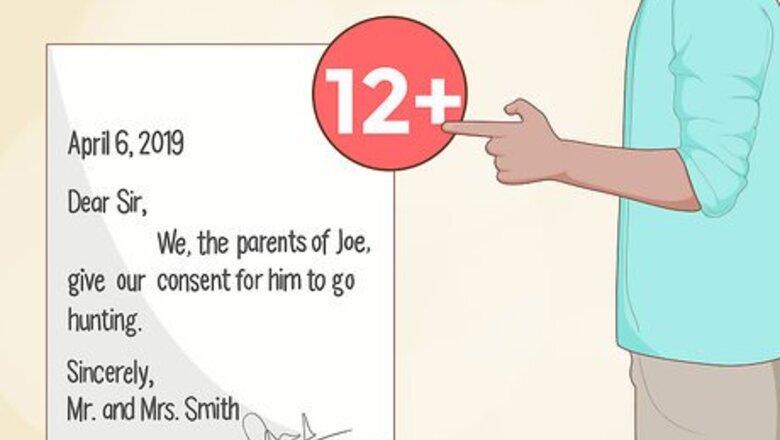
views
Meeting the Requirements
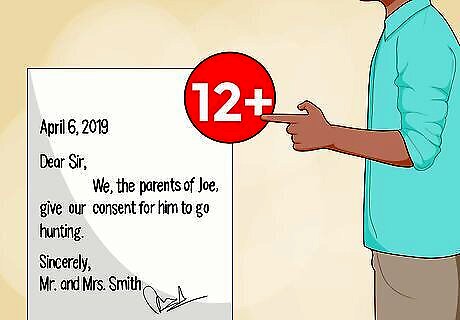
Be over the age of 12. In most states, you can get a hunting license if you’re 12 or older. If you’re between the ages of 12 and 16, you need consent from a parent or guardian to get your license.
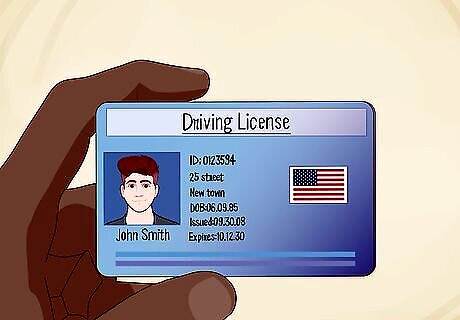
Have a valid ID. You are required to show proof of your identity in order to get a hunting license, so make sure you have a valid, current driver’s license, passport, or other state-issued photo identification card. Some states require that your ID be issued 6 months or more before you attempt to obtain a license.Tip: If you live in the state you plan to hunt in, provide proof of your residency to get a cheaper license. Plan to show a state-issued ID, tax return, voter ID card, property tax statement, or vehicle registration. Alternatively, provide 6 months worth of utility bills or pay stubs.

Make sure you’re legally allowed to operate a firearm. If you’ve been convicted of certain crimes, such as violent crimes or felonies, you may not be legally allowed to own or use a firearm. If this is the case, you cannot get a hunting license. If you aren’t sure if you can legally operate a firearm, check with your local law enforcement agency. This rules applies even if you plan to bow hunt.
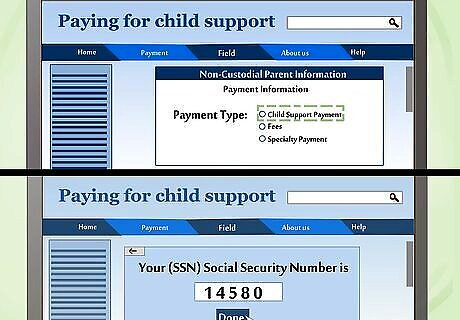
Be up-to-date with any child support payments, if applicable. You must provide your social security number in order to obtain a hunting license. If you are noncompliant with child support payments, you will not be issued a hunting license. Any existing hunting licenses you hold are invalid if you are noncompliant with child support payments.
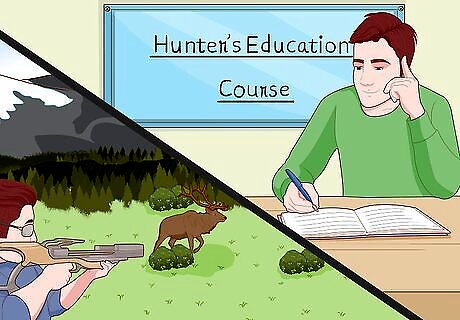
Take a hunter’s education course if necessary. The requirement to take a hunter’s education course varies by region, so check with your state’s wildlife or fish and game department to determine if you need one and how to obtain one. In many cases, you are required to take a 2-part course that consists of both in-class instruction and a field test that demonstrates you can safely operate a firearm (even if you plan to trap or bow hunt). You may be able to do the instructional part of the class online and only attend the firearm safety portion in person. Some people may be able to test out of hunter’s education, including active or veteran military members. You'll receive a hunter's safety card when you successfully complete the course.
Obtaining a License

Apply for a license in the state you wish to hunt. You don’t have to live in a state in order to hunt there. In fact, many hunters travel to other states to hunt different species. Just make sure that your license is valid for the state you plan to hunt in.Did you know? You need a license no matter how you plan to hunt, whether you are going to use traps, a firearm, or a bow.
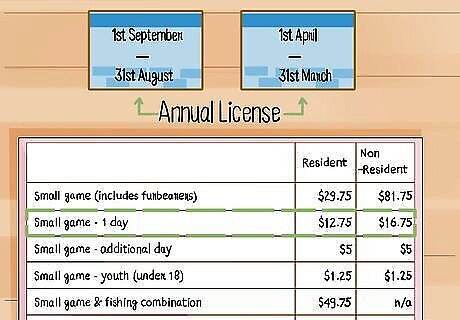
Select an annual license in most cases. Typically, hunters opt for an annual license. This allows them to hunt over the period of a single year (generally from September 1st to August 31st or April 1st to March 31st). However, many states issue short-term licenses (such as 1-day, 2-day, and 5-day licenses). If you're a non-resident or only want to hunt for a short period, this may be a more cost-effective option. Many states offer lifetime hunting licenses, which you may want to opt for if you are a dedicated hunter.
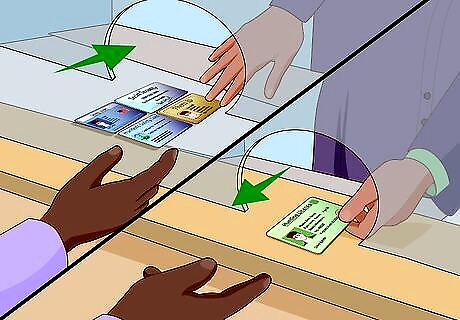
Get an over-the-counter license at a local sporting goods store. In many cases, you can purchase a license from any retailer that sells hunting equipment. Simply approach the counter in the hunting and fishing department and tell the clerk what kind of license you want. Show a valid ID along with your hunter’s safety card and provide your social security number so they can enter your information in the Fish and Wildlife Services database. Pay the fee and they’ll print you a license right then and there. The cost of the license will vary depending on the type of license, the region, and in some cases, your age. In New York, you can get an annual hunting license for $22 if you’re between the ages of 16 and 69. If you’re older or younger, the license is only $5. Alternatively, an annual hunting license costs $17 for residents of Indiana and $80 for non-residents.Variation: If you don’t want to buy a license in person, you may be able to get one online, over the phone, or by mail. Reach out to your state’s fish and game or wildlife department to learn more.
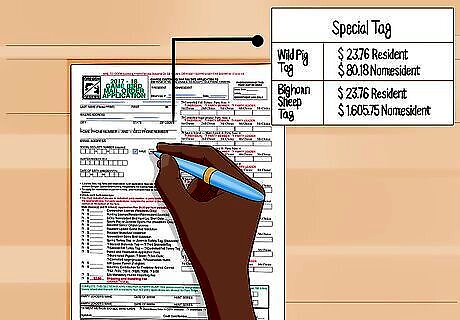
Apply for a special tag if necessary. Depending on what you want to hunt, you may need a tag for that specific animal. For instance, you can get a small game license which allows you to hunt animals such as rabbits, turtles, beavers, prairie dogs, squirrels, and bobcats. However, if you want to hunt big game, like elk, deer, or moose, in states including Colorado and California, you need to apply for the draw. This is a lottery-type program in which you submit information about the type of animal you want to hunt and the area in which you plan to hunt. You must wait to see if your request is approved, which can take several months. If your request is not approved, you may be able to buy an over-the-counter license for the same species later in the year. The region in which you can hunt the animal will likely be different than what you applied for. Certain states, including Colorado, require you to purchase a Habitat Stamp as well. This costs $10 per year and the money goes toward supporting the state parks and wildlife program. In other states, similar stamps may be referred to as “endorsements.”
Following the Law
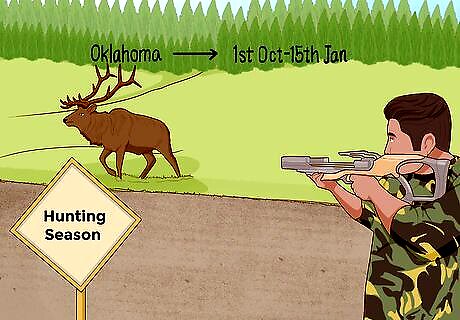
Hunt only during the designated season. Each animal, or group of animals, may only be hunted when they are “in season.” The type of hunting you wish to do (trapping versus hunting with a firearm or bow) also affects the season dates. These timelines vary by state, so check with your fish and game or wildlife department to find out when the animal you want to hunt is in season. For example, in Oklahoma, you can bow hunt deer from October 1st to January 15th. You can hunt deer with a firearm between November 23rd and December 8th. Be sure to hunt only during the designated hours as well, which are generally from sunrise to sunset or a half hour before sunrise to sunset.
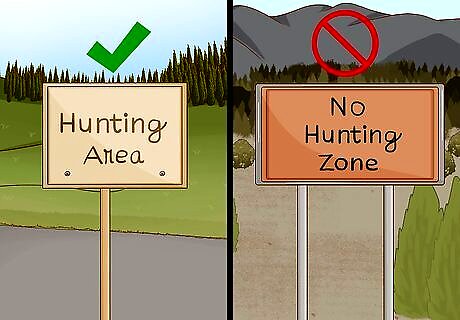
Stay within the authorized area. Most licenses restrict your hunting activity to certain areas, especially if you received a tag through the draw. It is your responsibility to make sure you remain in the designated area and you can be fined or even lose your license if you kill an animal outside of that area.Warning: Never hunt on private property without permission from the property owner.
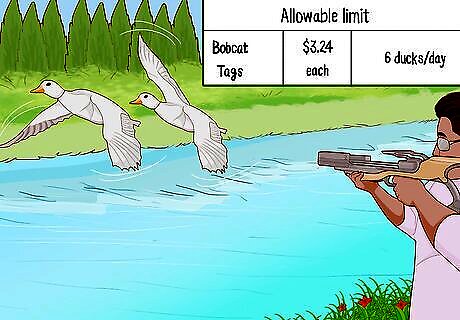
Abide by the allowable limits. For small animals like birds and squirrels, you may be able to hunt and kill more than 1 animal with a single license. However, there are strict limits about how many animals you can kill with that license or in a single day, so be sure to find out the limits for the state you’re hunting in. Alternatively, you may be able to purchase multiple tags for a single animal within a season. For example, in California, you can purchase up to 5 bobcat tags in a single year. In Pennsylvania, there’s a daily limit of 6 ducks or sea ducks.
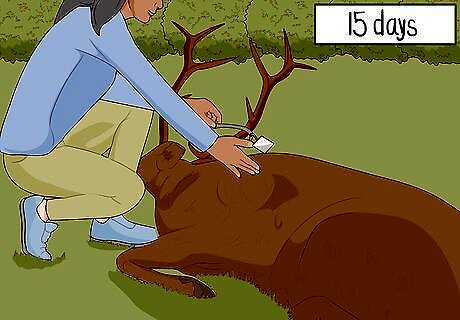
Attach the tag and report your kill, if required. Depending on the state and animal, you may be required to attach a tag to every animal you kill. Some states also require you to report both successful and unsuccessful hunts in order to track wildlife populations. Reach out to your wildlife or fish and game department to find out the rules for your area. For example, in California, both successful and unsuccessful deer hunters must report by January 31st. If you harvested a deer, you must keep the tag attached for 15 days after the end of the season. Failure to follow these rules results in a fine.












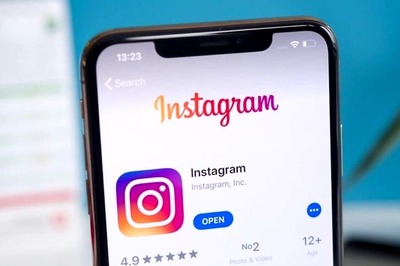







Comments
0 comment